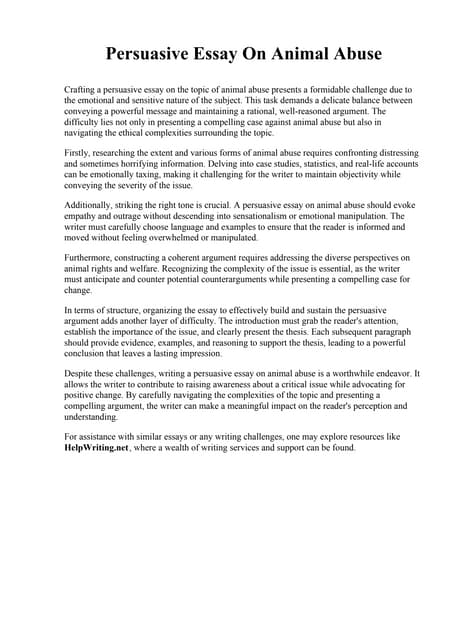Writing a persuasive essay on animal abuse is akin to embarking on a profound journey, where words serve as the catalyst for advocacy and change. The odyssey towards crafting a compelling narrative not only involves the meticulous selection of language but also an earnest exploration of the emotional and ethical landscapes that define our relationship with animals. With this in mind, the objective is to evoke empathy and inspire action through a structured and poignant essay.
Understanding Your Audience
Before penning the essay, it is imperative to discern the audience’s psyche. Are you addressing fellow activists, skeptics, or individuals ambivalent towards the plight of animals? The tone must resonate with the readers, drawing them into a shared emotional experience. By identifying their predispositions, you can tailor your narrative to either reinforce their beliefs or gently nudge them towards enlightenment. It’s important to incite curiosity while ripping away the veil of ignorance surrounding animal abuse.
Developing a Compelling Thesis Statement
Your thesis statement acts as the spine of your essay. It should be a crystalline assertion enveloped in passion. For instance, “Animal abuse is not merely an act; it is an indictment of our ethical fabric as a society.” This statement encapsulates the urgency of the subject matter, urging readers to reflect critically on the ethics of their behaviors. It anchors your argument, guiding the reader through the labyrinth of logic and emotion that follows.
Employing Emotional Appeals and Symbolism
Emotion is a powerful ally in persuasive writing. Share compelling anecdotes of individual animals who have suffered due to neglect, cruelty, or exploitation. Evocative narratives possess the unique ability to resonate deeply; these accounts cultivate compassion and outrage, which are vital for mobilizing action. An animal’s plight can symbolize broader systemic issues. Consider a metaphor where animals act as a mirror reflecting humanity’s moral decay. This juxtaposition serves to heighten the stakes, transforming the discussion from mere statistics to personal responsibility and moral obligation.
Incorporating Hard-Hitting Statistics and Facts
While emotional appeals are paramount, it is critical to buttress them with unwavering data. Statistics provide the scaffolding upon which your emotional narrative stands. Citing credible sources, indicate the prevalence of animal abuse. For example, “According to the ASPCA, approximately 1 million animals are abused every year in the United States.” Such data enhances the gravity of the situation, shifting the discourse from a sentimental one to an urgent call to action. Balance your narrative by interspersing statistics among personal stories to maintain a rhythmic flow between emotional and rational appeal.
Addressing Counterarguments
The art of persuasion lies not only in presenting your case with fervor but also in anticipating and addressing counterarguments. Acknowledge differing opinions with respect. For instance, some may argue that economic concerns hinder humane treatment of animals. Counter this by emphasizing the long-term societal and financial benefits of ethical treatment, such as reducing healthcare costs attributed to animal abuse. Strive to dismantle their arguments while remaining empathetic, thus inviting dialogue rather than confrontation.
Proposing Solutions and Action Steps
The pivotal aspect of a persuasive essay is not just highlighting the problem; it must also illuminate the path towards resolution. Offer tangible solutions, such as advocating for stricter laws against animal cruelty, support for local shelters, or community education programs. Each proposed solution should be accompanied by actionable steps that readers can take—signing petitions, volunteering, or simply spreading awareness on social media. This empowers the audience, transforming passive readers into proactive participants in the fight against animal abuse.
Crafting a Memorable Conclusion
A well-crafted conclusion is essential; it is the final note in your symphony of persuasion. Summarize the salient points succinctly and re-emphasize your thesis with renewed vigor. Leave your readers with a potent call to action, reminding them that their choices can transcend mere compassion and lead to meaningful change. As a metaphor, liken their potential impact to a pebble cast into a still pond, creating ripples that can ultimately reshape societal attitudes towards animals.
Polishing Your Prose
Finally, revise meticulously. A persuasive essay demands clarity, precision, and resonance. Fresh eyes can reveal nuances missed in initial drafts. Ensure the prose is devoid of ambiguity, and each passage flows seamlessly into the next. The artful use of rhetoric—such as parallelism, alliteration, or even poignant imagery—can elevate your writing from the mundane to the extraordinary.
In conclusion, writing a persuasive essay on animal abuse is not merely an academic exercise; it is a profound opportunity to drive societal change. Through emotional narrative, rigorous data, addressing counterarguments, proposing actionable solutions, and refining your prose, you can create a compelling call to arms. By inspiring empathy and mobilizing action, your words can echo far beyond the confines of the page, becoming a clarion call for a more compassionate world.








